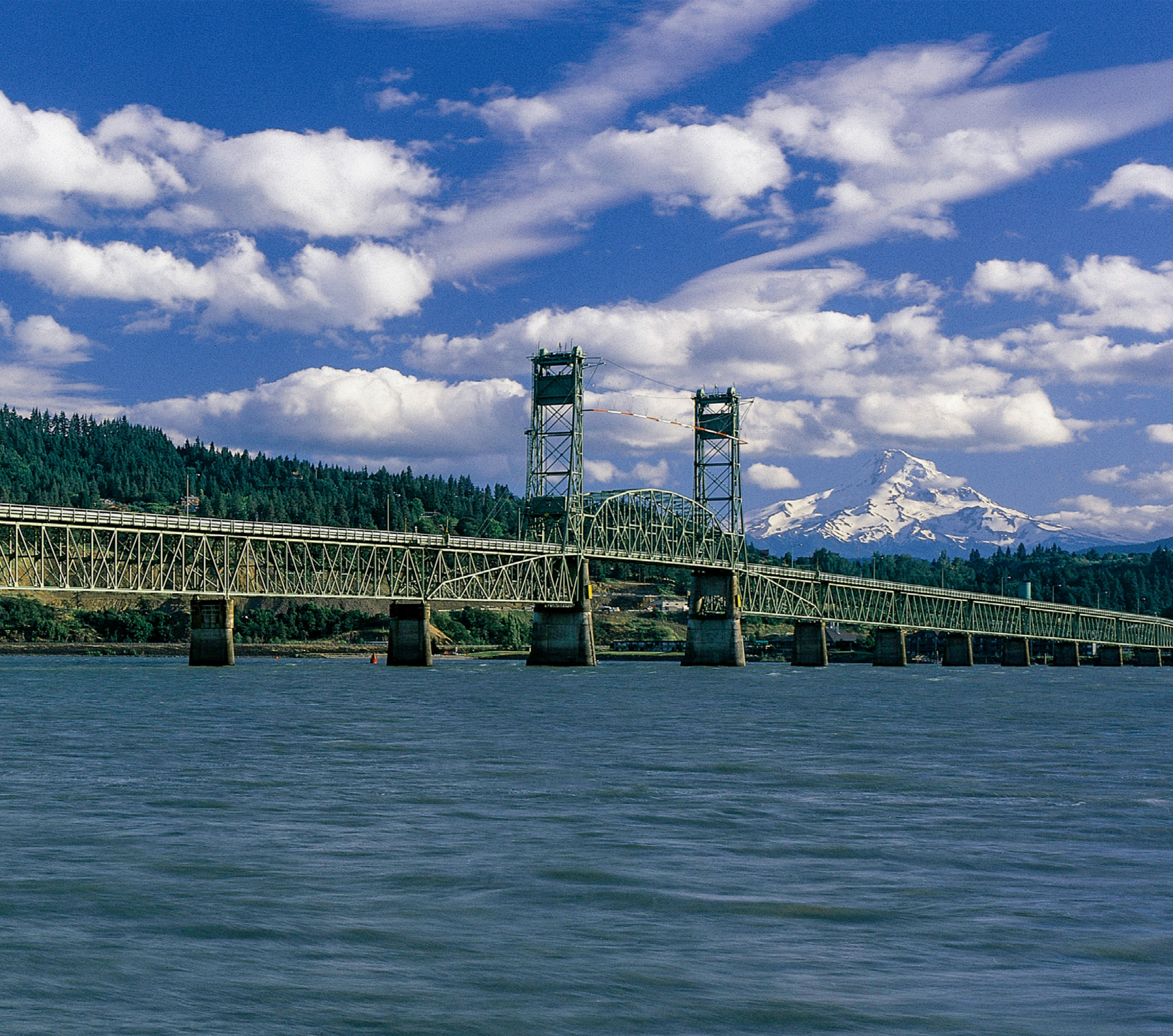
Current bridge & history
Today’s bridge was not built for the future
With narrow lanes, weight restrictions, no shoulders, difficult barge navigation, and no bike or pedestrian access, the Hood River Bridge does not meet our current needs. In addition, the existing bridge is not ready for an earthquake.
A deficient and outdated bridge
The Oregon Department of Transportation recently rated the bridge at 6 out of 100 for sufficiency. It is functionally at the end of its serviceable life. The Port estimates the existing bridge requires $52 million in repairs now and another $50 million to maintain it for the next 30 years.
The potential failure or closure of the bridge would “…have severe social and economic impacts on the interdependent, bistate communities” of the Columbia River Gorge National Scenic Area, as stated in the Summary to the Draft EIS of the SR-35 Columbia River Crossing Study completed in 2003.
4.5 million trips across the bridge annually.
3 million tons of wheat and barley, and significant amounts of petroleum and wood products are transported along the river annually.
55% of bridge users are Washington residents and 45% are Oregon residents.
Vital to a thriving economy
Hazardous for freight trucks
The bridge wasn’t built to safely accommodate our needs today or in the future. The steel deck bridge is structurally deficient for vehicle freight crossings, with only two very narrow (9’ 4.75” wide) lanes and no shoulders. The bridge is weight restricted and cannot accommodate modern vehicle freight hauling trucks and some emergency response vehicles.
The lanes are so narrow that losing mirrors off larger vehicles is common and trucks often get stuck together. Accidents like these cause hours-long delays and the nearest detour is 50 miles round trip.
Learn more about current weight limits and bridge restrictions.
A navigational nightmare
Watch a barge operator navigate through the narrow passage under the Hood River Bridge.
The Hood River Interstate Bridge is one of the most challenging bridges on the Columbia River System for barge operators. Only one vessel can navigate the opening at a time while marine freight traffic on the lower Columbia River continues to grow. Barge operators annually haul more than 3 million tons of wheat and barley, and millions of barrels of petroleum products, logs and wood chips.
The current bridge’s 246-foot navigational channel under the lift span is poorly aligned, insufficient, and dangerous for the commercial cargo barges navigating the federal inland waterway. In 2015, a barge tow collided with the bridge’s north lift span pier that caused at least $1.1 million in damage. The lift span remained closed for almost a year before repairs were completed.
In 2012, more than 9 million tons of commercial cargo traveled under the bridge’s lift span accounting for at least 30% of imports and exports on the marine route from Portland/Vancouver to Lewiston, Idaho.

A critical emergency link
The bridge helps us reroute interstate traffic during wildfires, major weather events and serious accidents. During the destructive Eagle Creek Fire in 2017, more than 50,000 acres burned on both the Oregon and Washington sides of the Columbia River Gorge. The Hood River Bridge was a vital route for mandatory evacuations, emergency services and fire fighters on both sides of the river.
It’s also used to connect Washington residents to life-saving medical services in Oregon. Because there are no labor and delivery services in White Salmon or Bingen, Washington, all babies in the area are born in Hood River, Oregon. When the bridge shut down for three days in the summer of 2022, expecting parents were advised to reschedule c-sections or find lodgings in Hood River.
The bridge will also play a central role in response to a major seismic event.
No bicycle or pedestrian access
The existing bridge has no bicycle or pedestrian facilities. People cannot commute or travel across the bridge by walking or bicycling. This lack of safe multi-modal access disproportionately affects low-income and minority communities.
It also fails to serve recreational or tourism interests of the Gorge, like connecting the future Historic Columbia River Highway to bike trails in Washington State.
History of the bridge
The mile-long Hood River-White Salmon Interstate Bridge, or commonly known as the Hood River Bridge, is a truss bridge with a vertical lift that spans the Columbia River at approximately river mile 169.8 between Hood River, Oregon and White Salmon, Washington. It connects Interstate 84/U.S. Route 30 on the Oregon side with Washington State Route 14.
Built in 1924, the bridge is currently the second oldest road bridge across the Columbia River between Washington and Oregon. It was originally called the Waucoma Interstate Bridge.
In 1938, construction of the Bonneville Dam downstream forced the original bridge to be altered to accommodate the resulting elevated river levels.
On December 12, 1950, the Port of Hood River purchased the bridge from the Oregon-Washington Bridge Company. The bridge is operated as a toll bridge by the Port.
The Bridge was built by the Oregon-Washington Bridge Company and opened to traffic on December 6, 1924.
Photo courtesy of HistoricHoodRiver.com.





